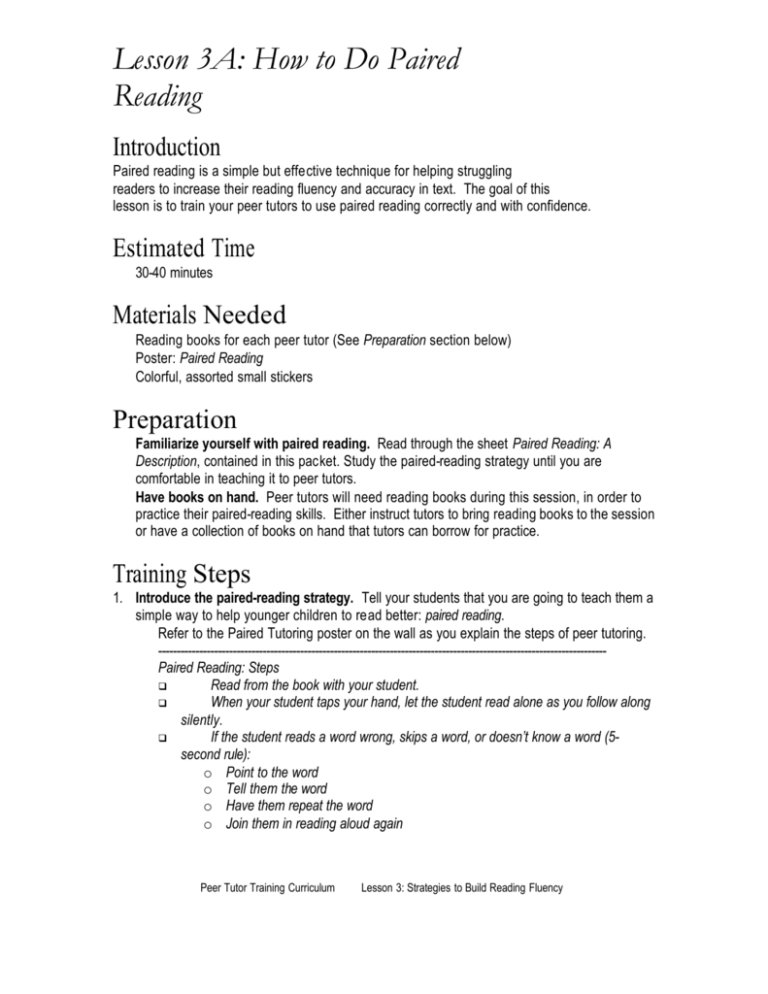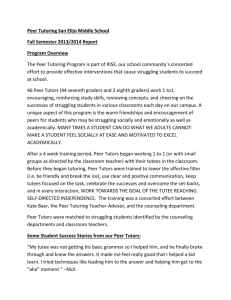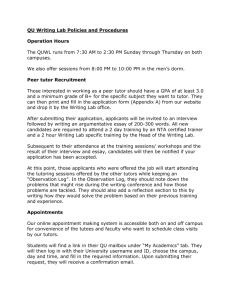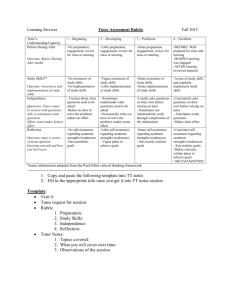How to Do Paired Reading
advertisement

Lesson 3A: How to Do Paired Reading Introduction Paired reading is a simple but effe ctive technique for helping struggling readers to increase their reading fluency and accuracy in text. The goal of this lesson is to train your peer tutors to use paired reading correctly and with confidence. Estimated Time 30-40 minutes Materials Needed Reading books for each peer tutor (See Preparation section below) Poster: Paired Reading Colorful, assorted small stickers Preparation Familiarize yourself with paired reading. Read through the sheet Paired Reading: A Description, contained in this pac ket. Study the paired-reading strategy until you are comfortable in teaching it to peer tutors. Have books on hand. Peer tutors will need reading books during this session, in order to practice their paired-reading skills. Either instruct tutors to bring reading books to the session or have a collection of books on hand that tutors can borrow for practice. Training Steps 1. Introduce the paired-reading strategy. Tell your students that you are going to teach them a simple way to help younger children to re ad better: paired reading. Refer to the Paired Tutoring poster on the wall as you explain the steps of peer tutoring. -----------------------------------------------------------------------------------------------------------------------Paired Reading: Steps Read from the book with your student. When your student taps your hand, let the student read alone as you follow along silently. If the student reads a word wrong, skips a word, or doesn’t know a word (5second rule): o Point to the word o Tell them the word o Have them repeat the word o Join them in reading aloud again Peer Tutor Training Curriculum Lesson 3: Strategies to Build Reading Fluency Kids As Reading Helpers: A Peer Tutor Training Manual Copyright 2002 by Jim Wright www.interventioncentral.org L3-3 -----------------------------------------------------------------------------------------------------------------------Pick a student from the group. Tell him or her to play -act the role of a younger reader. Encourage your student to read somewhat haltingly and to make an occasional reading error. With the student as your ‘tutee’, demonstrate the paired-reading strategy. At the end of the demonstration, ask whether students have any questions about how to do paired reading. NOTE: Be sure that students understand that they should wait at least 5 seconds before supplying the correct word to a hesitant reader. Have them practice the ‘1-Mississippi, 2Mississippi…’ mental counting method to monitor the appropriate wait-time. Also, model the use of praise as you demonstrate paired reading by occasionally praising the effort or reading ability of your ‘tutee.’ 2. Have students practice paired reading with each other. Divide students up into pairs. Instruct each pair that one student is to assume the role of tutor and the other is to pretend to be the tutee. Have the pairs practice paired-reading about 5 minutes while you circulate around the room observing and providing encouragement and corre ctive feedback. Then direct the pairs to trade roles, with the former tutee taking the role of tutor and vice versa. Give them an additional 5 minutes to practice under your supervision. 3. Hand out peer tutoring badges and award stickers. To show tutors that they have done a good job during this lesson, hand out their peer tutoring badges. Allow tutors to select and affix a sticker to their badges, signifying that they have successfully completed the lesson. Then collect the badges. Evidence of Student Mastery: ”Look-fors” Students who have mastered the Paired Reading lesson show through simulated peer-tutoring sessions that they: grasp the essential steps of paired reading. understand and readily respond to a tutee’s signal to read independently. promptly supply the correct word and have the tutee repeat the word whenever the tutee misreads a word in the text. monitor tutee hesitations in decoding words and supply the correct word after 5 seconds. resume reading in unison with the tutee after each reading error or hesitation of 5 seconds or more. provide occasional (and appropriate) praise to the tutee for reading ability or effort during paired reading. Peer Tutor Training Curriculum Lesson 3: Strategies to Build Reading Fluency Kids As Reading Helpers: A Peer Tutor Training Manual Copyright 2002 by Jim Wright www.interventioncentral.org L3-4 Paired Reading: A Description Description: The student reads aloud in tandem with an accomplished reader. At a student signal, the helping reader stops reading, while the student continues on. When the student commits a reading error, the helping reader resumes reading in tandem. Materials: Reading book Preparation: The teacher, parent, adult tutor, or peer tutor working with the student should be trained in advance to use the paired-reading approach. Intervention Script: 1. Sit with the student in a quiet location without too many distractions. Position the book selected for the reading session so that both you and the student can easily follow the text. 2. Say to the student, “Now we are going to read aloud together for a little while. Whenever you want to read alone, just tap the back of my hand like this [demonstrate] and I will stop reading. If you come to a word you don’t know, I will tell you the word and begin reading with you again.” 3. Begin reading aloud with the student. If the student misreads a word, point to the word and pronounce it. Then have the student repeat the word. When the student reads the word correctly, resume reading through the passage. 4. When the child delivers the appropriate signal (a hand tap), stop reading aloud and instead follow along silently as the student continues with oral reading. Be sure occasionally to praise the student in specific terms for good reading (e.g., “That was a hard word. You did a nice job sounding it out!”). 5. If, while reading alone, the child either commits a reading error, skips a word or line, or hesitates for longer than 5 seconds, point to the error-word and pronounce it. Then tell the student to say the word. When the student pronounces the error-word correctly, begin reading aloud again in unison with the student. 6. Continue reading aloud with the student until he or she again signals to read alone. Reference: Topping, K. (1987). Paired reading: A powerful technique for parent use. Reading Teacher, 40, 608-614.





